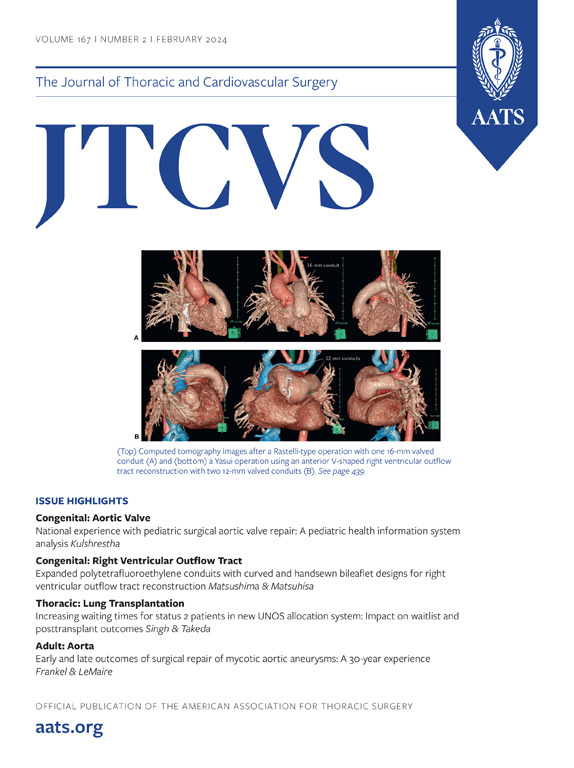双肺移植后的单肺再移植结果
IF 4.4
1区 医学
Q1 CARDIAC & CARDIOVASCULAR SYSTEMS
Journal of Thoracic and Cardiovascular Surgery
Pub Date : 2024-09-30
DOI:10.1016/j.jtcvs.2024.09.039
引用次数: 0
摘要
研究目的本研究旨在比较初次双肺移植后进行单肺再移植(SLRTx)和双肺再移植(DLRTx)的结果:方法:对2005年5月至2022年12月期间的器官获取与移植网络/器官共享联合网络数据库进行了回顾性分析。方法:对2005年5月至2022年12月期间的器官获取与移植网络/器官共享联合网络数据库进行了回顾性分析,排除了多器官移植、重复再移植以及初次移植状况不明的肺再移植:分析共纳入891例患者:698例(78.3%)为DLRTx,193例(21.7%)为SLRTx。DLRTx患者的平均肺分配评分更高(59.6±20.7 vs 55.1±19.3,P = 0.007)。体外膜肺氧合(ECMO)桥接肺移植的使用情况在各组之间相似(P=0.125),等待时间也相似(P=0.610)。DLRTx组在移植后72小时内需要机械通气(54.6% vs 35.8%,p=0.005)和ECMO(17.9% vs 9.0%,p=0.069)的频率更高。然而,移植后中位住院时间(21.5 [IQR 12-35] vs 20 天 [IQR12-35],p=0.119)和院内死亡率(10.9% [76/698] vs 12.4% [24/193],p=0.547)在两组之间不相上下。DLRTx组的长期生存率明显更高(对数秩检验 p < 0.001)。在倾向分数加权多变量模型中,DLRTx与SLRTx相比,在随访期间任何时间点的死亡风险均低28%(HR:0.72,95%置信区间:0.57-0.91,P=0.006):结论:在再移植情况下,单肺移植的创面较小,短期获益甚微,但长期生存率却明显较低。双肺再移植仍应是初次双肺移植后进行肺再移植的标准。本文章由计算机程序翻译,如有差异,请以英文原文为准。
Outcomes of single-lung retransplantation after double-lung transplantation
Objective
To compare outcomes of single-lung retransplantation (SLRTx) and double-lung retransplantation (DLRTx) after an initial double-lung transplantation.
Methods
The Organ Procurement and Transplantation Network/United Network for Organ Sharing database between May 2005 and December 2022 was retrospectively analyzed. Multiorgan transplantations, repeated retransplantations, and lung retransplantations when the status of the initial transplantation was unknown were excluded.
Results
A total of 891 patients were included in the analysis, included 698 (78.3%) with DLRTx and 193 (21.7%) with SLRTx. The mean lung allocation score was higher in the DLRTx group (59.6 ± 20.7 vs 55.1 ± 19.3; P = .007). The use of extracorporeal membrane oxygenation (ECMO) bridge to lung transplantation was similar in the 2 groups (P = .125), as was waitlist time (P = .610). The need for mechanical ventilation (54.6% vs 35.8%; P = .005) and ECMO (17.9% vs 9.0%; P = .069) at 72 hours post-transplantation was greater in the DLRTx group. However, median post-transplantation hospital stay (21.5 [interquartile range (IQR), 12-35] days versus 20 [IQR, 12-35] days; P = .119) and in-hospital mortality (10.9% [n = 76/698] vs 12.4% [n = 24/193]; P = .547) were comparable in the 2 groups. Long-term survival was significantly better in the DLRTx group (P < .001, log-rank test). In the propensity score–weighted multivariable model, the DLRTx group had 28% lower risk of mortality at any point during follow-up compared to the SLRTx group (hazard ratio, 0.72; 95% confidence interval, 0.57-0.91; P = .006).
Conclusions
The less invasiveness of single-lung transplantation in the retransplantation setting has minimal short-term benefit and is associated with significantly worse long-term survival. Double-lung retransplantation should remain the standard for lung retransplantation after initial double-lung transplantation.
求助全文
通过发布文献求助,成功后即可免费获取论文全文。
去求助
来源期刊
CiteScore
11.20
自引率
10.00%
发文量
1079
审稿时长
68 days
期刊介绍:
The Journal of Thoracic and Cardiovascular Surgery presents original, peer-reviewed articles on diseases of the heart, great vessels, lungs and thorax with emphasis on surgical interventions. An official publication of The American Association for Thoracic Surgery and The Western Thoracic Surgical Association, the Journal focuses on techniques and developments in acquired cardiac surgery, congenital cardiac repair, thoracic procedures, heart and lung transplantation, mechanical circulatory support and other procedures.

 求助内容:
求助内容: 应助结果提醒方式:
应助结果提醒方式:


